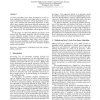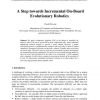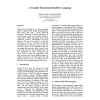884 search results - page 92 / 177 » Control structures in programs and computational complexity |
IFL
1997
Springer
13 years 12 months ago
1997
Springer
Common subexpression elimination is a well-known compiler optimisation that saves time by avoiding the repetition of the same computation. In lazy functional languages, referential...
JAIR
2011
12 years 10 months ago
2011
There has been significant recent interest in game theoretic approaches to security, with much of the recent research focused on utilizing the leader-follower Stackelberg game mo...
CATS
2008
13 years 9 months ago
2008
Lock-free algorithms have been developed to avoid various problems associated with using locks to control access to shared data structures. These algorithms are typically more int...
SCAI
2001
13 years 9 months ago
2001
We apply evolutionary algorithm (EA) to the design of controller for adaptive robots. EAs can be successful for more complicated tasks, where traditional engineering methods strugg...
SFP
2004
13 years 9 months ago
2004
NiMo (Nets in Motion) is a visual environment aimed to support totally graphic programming in Data Flow style, with a strong functional inspiration. Solutions of growing complexit...



